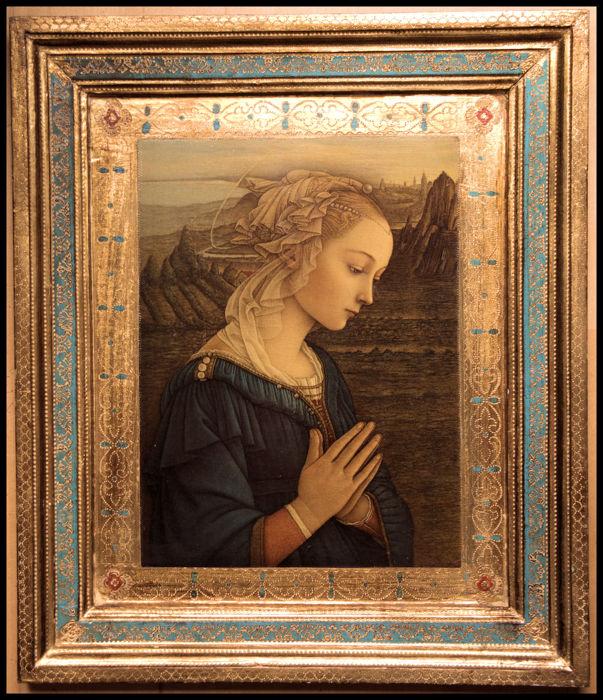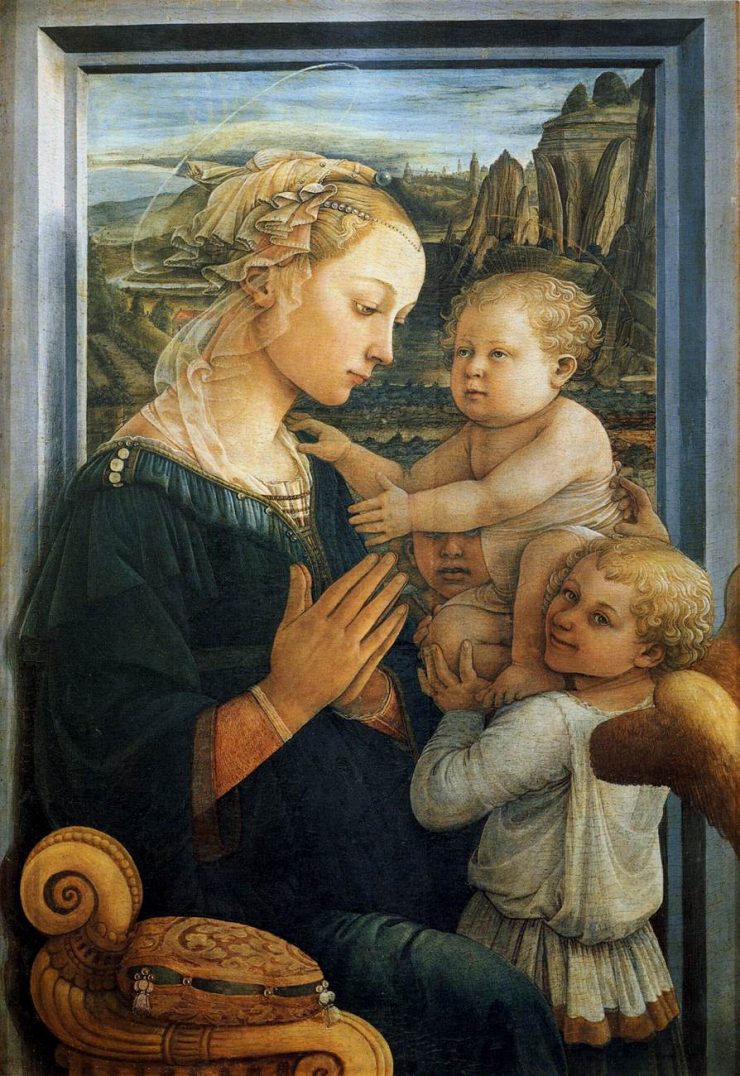Visual Poetry
In this painting Lippi took a traditional holy image and gave it a strong sense of humanity, both through the emotion in the expression of affection between the family members, and in the choice of clothes and hairstyles, which were inspired by the fashions of the period. It has a particularly strong emotional concept that works in two parallel modes: the story it is depicting, and the real life feelings in a family.
The Virgin, who was most likely Lucrezia Buti, the young nun from Prato, who went on to become Lippi’s wife, is elegantly dressed with a crown of pearls and veils woven into her hair, in the same way as Florentine noblewomen from the late 15th century.
The portrait of the Virgin Mary is painted meticulously as a beautiful woman. This was the first time this had been done.The emotion it evokes is probably heightened because of the artist’s obvious personal feelings for the model, and the fact that the models were his family.
Visual Music
In terms of Visual Music, the beauty of the model is echoed in the beautiful Ess organizational structure and graceful line that ties the composition together, rather than just the traditional triangular organizational structure.
The composition was a success from the start, and used as a model by many artists, including the young Botticelli, a pupil of the artist.
Comments by students
Here are some more insights into this painting, by one of our advanced Virtual Art Academy students, Sue.
“This beautiful painting has an informality which makes it look more like a family portrait than a religious work. The composition with the seated Madonna and child and angels is fairly conventional but the way it is framed by the window and chair makes it look remarkably modern. The extension of the angel’s wing over the frame and out of the picture is a wonderful touch.
There are things I find odd about the composition. The background scene is a serene country landscape but the curve of the river at the top left gives the impression that the river is part of the Madonna’s head…almost like a second halo. It is also unusual that the second angel is partially obscured so his/her eyes can’t be seen. He/she is needed to give balance to the composition but also to make it look as if the angels are supporting the child. Whilst there are many leading lines pointing to the baby my attention was caught more by the face of the Madonna. The baby appears to gaze at the Madonna but her gaze seems to be directed at the smiling angel and the angel seems to be looking out of the picture just to the left side of the viewer.
The palette is beautifully harmonious and fairly sombre…low saturation greeny blue and orangy red (and yes, i should probably use Munsell notation but…). There are beautiful details in the dress and hair.
I have also posted Adoration of the virgin (which Google suggests this is called).

It is obviously the same figure as in the Madonna…and the same background. It is not uncommon for a artist to repeat a theme but this degree of ‘cut and paste’ is unusual. More googling also suggests it may be a copy by a follower of Lippo Lippi rather than by the master himself. Looking in detail at the Adoration (and photos and screens and time make it difficult to be sure) it appears that the Adoration has a flatness and lack of subtlety. The colours are less rich and don’t have the ‘glow’ that the Madonna has. The face and shoulder are slightly flatter, less womanly in some ways.
Interestingly I can’t find anything online to the effect that the two figures are the same. I haven’t studied in any depth and it might be a well known fact but I found it very intriguing.
Thanks for the challenge Barry!”
“Thank you Sue for pointing out this relation between the two paintings. It is quite clearly a copy. Nearly all studies are different from the final painting because the artist changes his/her mind when doing the final work. But this one is identical, suggesting it was a deliberate copy.
Your comment about looking more like a family portrait rather than a religious painting was interesting. The Madonna is his wife, and the boy looking at us mischeiviously is his son Filippino, who in his own right became a great painter.”
Barry
For more information
For more information on my Visual Music & Poetry® model, and critiquing art, see the online painting classes in year one of our Apprentice Program.
Please share this article!
Thank you
Barry
